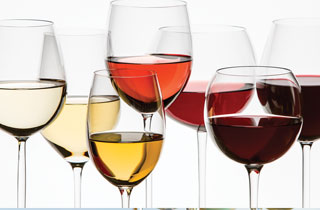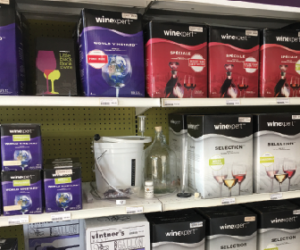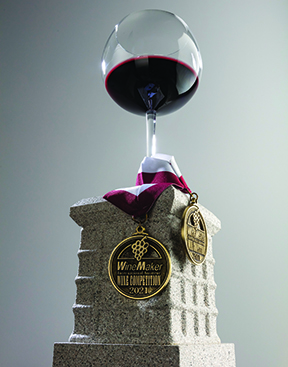
Each year WineMaker magazine sends out a survey to readers to elicit feedback on a wide range of topics and demographic information. When it to comes one question in particular: “How do you feel about the mix of stories in WineMaker magazine?” year-in and year-out, we get a large number of the same exact responses that fall into either camp A or camp B; either too little or too much content covering wine kits. What’s more amazing is that it is always about the same percentage in
both camps.
Unfortunately, wine kits are sometimes looked at by fresh-grape winemakers as either an inferior type of winemaking or as producing an inferior wine. But the reality is every year, without fail, at our WineMaker International Amateur Wine Competition where kits are judged blind side-by-side with the fresh-grape wines, the kit wines perform very well.
Many fresh-grape winemakers have recently taken notice of this and have added kits into their winemaking repertoire. Whether you are new to the winemaking hobby, a kit winemaker looking to up your game, or a fresh-grape winemaker curious about kit wines . . . this roundtable is for you. We tracked down four highly decorated kit winemakers to ask what they’re doing to garner such high praise from judges in a blind tasting.
Award-Winning Kit Roundtable participants

Mike Dault started winemaking in 2011 was named the Winemaker of the Year in the 2021 WineMaker International Amateur Wine Competition, where he also won Best of Show Kit. This year he joined the Cincinnati Vintner Club and his backyard Cabernet Franc vineyard of 14 vines should provide some additional red grapes.
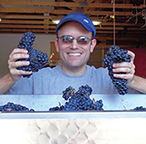
Clinton Kent leads business development for a division of an aerospace repair company and lives in Lexington, Kentucky with his wine-loving girlfriend and two dogs. He started making wines in 2012 and loves big, tannic, dry wines. He won the Best of Show Dessert wine in the 2021 WineMaker International Amateur Wine Competition.

Cody Shive is a Retail Transformation Consultant who has been an amateur winemaker since 2013. Since that time he has won numerous medals for his kit wines. He lives with his wife, Laura, and their dog, Siri, in Chapel Hill, North Carolina.
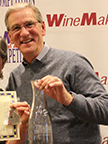
Larry Janke has been making wines in Minnesota for years and has taught classes for amateur winemakers. He is also a wine judge and won Best of Show Kit in the 2019 WineMaker International Amateur Wine Competition, in addition to top honors at other competitions.
Starting Out
1) What are your favorite types of wines to make from kits?
Clinton Kent: I most enjoy Port-styles, ice wines, or summertime porch-style wine coolers.
Cody Shive:The ones that my friends and family enjoy drinking, regardless of what awards they may (or may not) have won.
Mike Dault:The country fruit kits and the Port-style kits are my favorites.
Larry Janke: I like them all. I prefer red wines, so I tend to gravitate to the big red varietals. Cabernet, Malbec, Shiraz, and Grenache. It is nice to have a good Pinot Grigio or Sauvignon Blanc ready for a before-dinner drink. And in the summer, it is not uncommon for me to enjoy a good Riesling or Moscato. I can actually say with the utmost confidence that I have never made a kit wine that I didn’t enjoy.
2) What would be your best piece of advice to someone just getting into the hobby, and going out to purchase their first kit?
Cody Shive:Get a “starter” equipment kit so you aren’t scrambling at the last minute for kit-making components. Purchase a low-cost kit — this is the kit you’ll make your mistakes with and you don’t want to have put a lot of money into it for learning purposes. Start with a white wine kit — they are ready 1–2 months after bottling. You’ll learn more about mistakes you made (or not) starting out with a white wine than you will with a red wine. Use bottled spring water to reconstitute the wine kit — DO NOT use tap or well water. Tap water may have chlorine or fluoride in it. Well water could have a lot of iron or be contaminated with bacteria. Be a fanatic about sanitation: If you think it’s clean, wash it again. Then follow the kit’s
directions exactly.
Clinton Kent: Pick what type of wine you like to drink. Buy the most expensive kit you can afford and follow the directions exactly.
Mike Dault:I would recommend beginning with something like an Orchard Breezin’ (RJS) or Island Mist (Winexpert) kit as they are ready to drink in about two to three months after bottling. This gives the beginner a feel of winemaking procedures and you don’t need to wait a long time to enjoy it. Also, see the various articles about sanitation at winemakermag.com.
3) Is there any equipment that you wish you had when you started that you would recommend to a new winemaker?
Larry Janke: The bottle tree, a bottle rinser, wine degasser tool, and a good corker. None of those items came with the starter equipment package.
Mike Dault:Auto-siphon with the white colored, spring-activated wine filler. I learned that it always works best to keep the plastic tube on the end of the hose to provide some added weight so the hose doesn’t pop out of the bucket.
Cody Shive:A whip to drive the CO2 out of the wine.
Clinton Kent: When I first started with barrels, I wish someone had told me about Platypus PlatyPreserve Wine Bags. For $10, they are reusable and are great for topping up barrels or carboys. You can then squeeze the bag to eliminate the headspace before putting the cap back on.
4) What resource (other than a subscription to WineMaker magazine of course) would you say is the best for
new kit winemakers?
Clinton Kent: I love morewinemaking.com’s free online “MoreManuals” at the bottom of their homepage.
Cody Shive:There are several good books, but Daniel Pambianchi’s Kit Winemaking: The Illustrated Beginner’s Guide to Making Wines from Concentrate is the one I go back to repeatedly.
Mike Dault: Winemakermag.com articles. In 2016, I branched out and made a blueberry wine. I used a “Tips from the Pros” article as a guide and after a bit of tweaking, got the Best of Show Country Fruit in 2019 on a blend of raspberry, blueberry, and blackberry.
Larry Janke: First Steps in Winemaking by Cyril Berry does a good job with explaining the basics in understanding the process, but Techniques in Home Winemaking by Daniel Pambianchi is my go-to reference for everything wine-related.
Planning Ahead
5) What guides your decisions when planning which wine kits you’ll be purchasing for the next few batches?
Mike Dault:Since my job requires travel, I try to start a lot of wines around the holidays, and that works out perfect for the summer wines and Port-style kits that I use as Christmas gifts the following year.
Clinton Kent: I am a sucker for limited edition wine kits.
Cody Shive:I like to do white wine kits in the spring so they are ready for the summer. I like to get red wine kits started in the summer, because the fermentation temperatures are easier to manage in the summer than they are in the winter for me.
Larry Janke: Actually, it depends on the cellar and what we are consuming. The red wines need to age longer, so we have to plan ahead about six months. If the white wine is dwindling, we can have that ready sooner.
6) Each kit comes with a recommended aging cycle. Do you find yourself mostly adhering to those timelines or do you adjust it often based on other factors?
Larry Janke: I tend to age the wines a little longer than recommended. The white wines are drinkable almost right away, but really improve after just a few months. The red wines I like to age about a year. Kit wines really should be consumed within 18 – 24 months. They really aren’t designed for long-term cellaring.
Mike Dault:I follow the kit recommendations for the most part and don’t get too excited if extending a week or so beyond what the kit says, especially after initial transfer as I use argon gas to fill up the carboy to reduce headspace.
Clinton Kent: I have never followed the aging timelines for red wines. They are far too short. Some red kits are magical, but only after aging a year.
Kit Adjustments
7) Are there any easy adjustments to a wine kit that you feel would be a good jumping off point for those looking to start making tweaks on their own?
Clinton Kent: I always fortify Port-style kits with brandy, cognac, or rum. They are too sweet for me otherwise . . . and I have a sweet tooth.
Cody Shive:Any change you make to a kit wine can have a major effect. I come from a QC/QA background, so I like to “baseline” my wines before I mess with them. I’ll typically make a wine exactly as the directions suggest. Then, with an identical kit, I’ll make one change (like, I’ll add extra oak — or if the kit didn’t come with oak, I’ll add it). I keep meticulous notes so I can compare the wines down the line to see which one turned out better. So, if you want to make changes, buy two identical kits. Make one exactly as the instructions suggest. Make the other one with only one change so you can know for certain the influence that change had.
Mike Dault:I stir in about 4 lbs. (1.8 kg) of granulated sugar in the beginning to raise the specific gravity (SG) to about 1.085 on the Orchard Breezin’/Island Mist kits.
Larry Janke: The kits have come a long way in the past few years to be acid balanced and stable. If an adjustment is made, it is to the individual’s taste. One could add sugar syrup to sweeten a white wine, or add a little oak or tannin to a red wine in secondary to add
some body.
8) For more advanced kit winemakers, any advice on the types of adjustments you feel have the potential to really elevate certain kits?
Mike Dault:On the white wines I use 71B or QA23 yeast. I use only spring water and fill to 5.5 gallons (21 L). I do a final transfer to a 5-gallon (19-L) carboy. The remaining liquid I bottle, usually 3 bottles or so. Then I leave the bulk wine in the carboy for another month or so. This results in a very clear 5 gallons (19 L) of wine without having to filter.
Cody Shive:Changes to oak concentrations can have a desirable effect, but go gently. The thing to keep in mind with kits is the kit makers have gone through multiple trials to make sure the wines come out consistently with little fuss.
Larry Janke: Once you are comfortable with the process, you can experiment with using different yeast strains to accentuate the fruit flavors, and different tannin and oak additions can really pop the flavors on a big red wine like a Cabernet or Nebbiolo.
Clinton Kent: A small barrel from Vadai Barrels does wonders for red or Port-style kits. Barrels will also fully degas the wine while you wait.
Advanced Strategies
9) Are there any advanced strategies or techniques that have benefitted your wines?
Clinton Kent: I love doing bench trials before bottling — particularly with acidity, tannin additions, or blending different batches of wine together. Experiments are also fun to see the impact of different yeasts and winemaking techniques.
Larry Janke: Adding the right amount of metabisulfite before bottling has been a great benefit to me for stabilizing red kit wines so that they will age gracefully and last longer in the cellar. Advanced SO2 and pH testing equipment is necessary for this step.
Mike Dault:On the Port-style wines I usually add about 5% brandy to help with overall taste and ABV.
Cody Shive:Filtering my red wines has given me better long-term outcomes than with my non-filtered wines, which was very surprising to me.
10) While you can buy kits that are already grape blends, is blending different kits a strategy that you recommend?
Larry Janke: I’ve created some nice Bordeaux- and Tuscan-style blends. Once the individual kits have finished fermenting, I do bench trials to taste test what percentage of each wine works the best. The trial that wins then is tested for pH and SO2 balance before it is bottled. Blending can throw off the balance of the finished wine.
Cody Shive:Yes! Making two kits and then blending them before bottling can yield a wonderful benefit. So, consider making a Pinot Noir kit and a Shiraz kit. Then, at the end, blend them before bottling. That will produce something unique, and because you’ve followed the directions on each of the kits, your new 50/50 resulting wine will be one-of-a-kind.
Clinton Kent: Absolutely! Let your taste buds guide you. It’s also fun combining grapes from different parts of the world.
Mike Dault:That is where the creativity kicks in and makes it fun. I have blended my raspberry wine made from fresh fruit with the peach kit wine and that came out awesome.
11) Are there any advanced pieces of equipment you recommend to other winemakers that are comfortable in kit winemaking?
Mike Dault:I like the FastRack as opposed to a bottle tree for drying bottles, as it is more sanitary. Using a floor corker is so much easier and worth the investment. Also, having a small bottle of argon gas helps with topping up carboys for a week or so.
Clinton Kent: I’d recommend a different method for degassing kit wines. I have never had much luck with simply stirring. Barrels work well. A vacuum pump works. I use a less common technique with an air compressor and a small plastic venturi ejector.
Larry Janke: A good pH meter was the first item I purchased. Next would be a Mini Jet filter and an Enolmatic bottle filler. I also have a wine capsule heat shrinker.
Cody Shive:A small pad filter, like Buon Vino Mini Jet or similar. Also, I use a Clean Bottle Express to clean the inside of my carboys. It’s a drill-mounted wand with cleaning pads that scrub the inside. A good bottle cleaner (same company as above makes one). Also, a bottle rinser that goes on the kitchen faucet and a floor-corker.
Bringing It All Together
12) What do you believe sets award-winning quality wines made from kits apart from others?
Cody Shive:Sanitation, for sure. Following the directions. Attention to detail during production. Storing wines in a temperature-constant area. Some people think the high-end kits will get you awards. Not necessarily so. I’ve received awards for $50 kits as well as $180 kits. It’s a combination of kit and what you do when you make the kit.
Mike Dault:Quality of the kits and experimenting to see what works or doesn’t work. I still remember from my first winemaking class it was said to always make a wine that you will like and don’t expect perfect wines every time. I believe it was 10% will be non-drinkable, 20% might be awesome, and the rest just OK.
Clinton Kent: I have read that judges see a lot of defects from cleanliness and sanitation issues. In my own experience, make the wine that you love to drink. Even if it does not score well, you will still love drinking it! My own palate does not always match up with medals/scores, and I still prefer some of my lower scoring wines.


